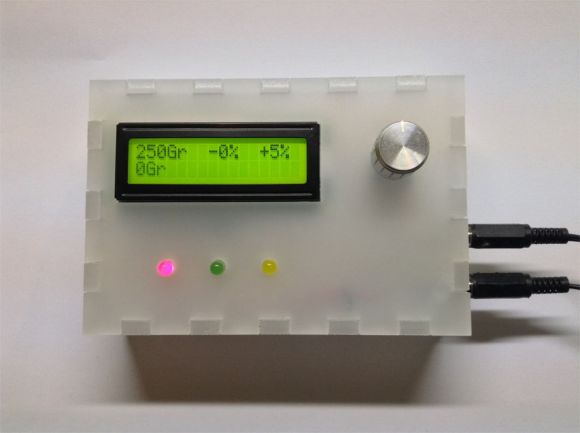
[Jan] works with both physically and mentally disabled individuals, some of whom cannot read, making many of their tasks more difficult. Although [Jan] is not in a position to teach reading or writing skills, he was able to build an add-on device for the scales used in repackaging sweets to provide simple feedback that the user can interpret.
The device has three LEDs—red, green, and yellow—to indicate the package does not weigh enough (red), weighs too much (yellow), or lies within an acceptable range (green). The industrial scales at [Jan’s] workplace each have a serial output to connect to a printer, which he used to send data to the device. An ATMega8 controls the lights and an attached LCD, with the usual trimpot to change the display’s contrast and a rotary encoder to adjust the device’s settings. Everything fits snugly into a custom-made frosted acrylic enclosure, laser-cut at a local hackerspace.
[Jan] provides a rigorous guide to approaching each step on his Instructables page, along with source code and several pictures. See a video overview below, then enjoy another scale hack: building one from scratch.















This is an exceptionally good idea. I have worked with scales, gauging equipment, and the like. Even for fully adept people just some simplified feedback as opposed to the traditional method of interpreting measurements can save some serious amounts of time.
There may be a business opportunity in Jan’s imminent future.
It’s a nice build but every major manufacturer in the scale industry has offered products with this functionality built-in for decades.
That’s true. Even the scales that we use and that are in the pictures have a system where a + or – appears in the lcd but the people who I work it don’t even get that. They can’t read or write and most of them don’t understand simple symbols like +,- or =. I tried to teach them that but I just didn’t work out.
I gave them these little devices and within 5 min they worked with it and had no problems at all.
I agree with you that this isn’t a world shocking new idea. Its just my little solution for a problem that I face at work on a daily base. And it costs only about $20 so that is isn’t bad at all.
Probably worth mentioning the hack is that it only costs $20. Industrial checkweighers with more prominent checkweigh displays run $500 to $1000+. This little balance was probably under $200.